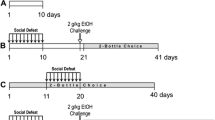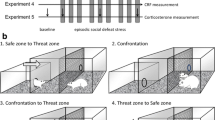Abstract
Rationale
Stressful life experiences can persistently increase the motivation for, and consumption of, intensely rewarding stimuli, like cocaine, over time. In rodents, intermittent versus continuous exposure to social stress engenders opposing changes to reward-related behavior, as measured by consumption of sucrose and cocaine.
Objective
The present study examines if the effects of intermittent versus continuous social stress on cocaine self-administration in mice parallel those seen in rats.
Methods
Both forms of social stress involve a brief daily physical confrontation with an aggressive resident for 10 consecutive days. Continuous social stress involves constant visual and olfactory exposure to an aggressive resident via habitation in a protected portion of the resident’s home cage, while exposure to an aggressive resident during intermittent social stress is limited to a single, physical encounter per day. Implementing a femoral vein catheterization method for the first time in mice, we determined divergent changes to intravenous cocaine self-administration.
Results
Modestly increased cocaine self-administration after intermittent social stress was confirmed. In a subset of animals, continuous social stress in mice substantially increased cocaine self-administration and sucrose intake. By stark contrast, another subpopulation had substantial attenuation of cocaine self-administration and sucrose intake after continuous social stress.
Conclusions
Bimodal divergence in responding for rewarding stimuli including cocaine after social stress experience likely reflects two opposing forms of coping to continuous social stress that promote either a sensitization or attenuation of reward-seeking.








Similar content being viewed by others
References
Ahmed SH, Badiani A, Miczek KA, Müller CP (2018) Non-pharmacological factors that determine drug use and addiction. Neurosci Biobehav Rev
Ahmed SH, Koob GF (1998) Transition from moderate to excessive drug intake: change in hedonic set point. Science 282(5387):298–300
Berton O, McClung CA, DiLeone RJ, Krishnan V, Renthal W, Russo SJ, Graham D, Tsankova NM, Bolanos CA, Rios M, Monteggia LM (2006) Essential role of BDNF in the mesolimbic dopamine pathway in social defeat stress. Science 311(5762):864–868
Björkqvist K (2001) Social defeat as a stressor in humans. Physiol Behav 73(3):435–442
Charney DS (2004) Psychobiological mechanisms of resilience and vulnerability: implications for successful adaptation to extreme stress. Am J Psychiatry 161(2):195–216
Collins SL, Kantak KM (2002) Neuronal nitric oxide synthase inhibition decreases cocaine self-administration behavior in rats. Psychopharmacology 159(4):361–369
Covington HE, Miczek KA (2001) Repeated social-defeat stress, cocaine or morphine. Psychopharmacology 158(4):388–398
Covington HE, Tropea TF, Rajadhyaksha AM, Kosofsky BE, Miczek KA (2008) NMDA receptors in the rat VTA: a critical site for social stress to intensify cocaine taking. Psychopharmacology 197(2):203–216
Czoty PW, Morgan D, Shannon EE, Gage HD, Nader MA (2004) Characterization of dopamine D 1 and D 2 receptor function in socially housed cynomolgus monkeys self-administering cocaine. Psychopharmacology 174(3):381–388
de Boer SF, Buwalda B, Koolhaas JM (2017) Untangling the neurobiology of coping styles in rodents: towards neural mechanisms underlying individual differences in disease susceptibility. Neurosci Biobehav Rev 74:401–422
de Groot J, van Milligen FJ, Moonen-Leusen BW, Thomas G, Koolhaas JM (1999) A single social defeat transiently suppresses the anti-viral immune response in mice. J Neuroimmunol 95(1–2):143–151
Der-Avakian A, Bland ST, Schmid MJ, Watkins LR, Spencer RL, Maier SF (2006) The role of glucocorticoids in the uncontrollable stress-induced potentiation of nucleus accumbens shell dopamine and conditioned place preference responses to morphine. Psychoneuroendocrinology 31(5):653–663
Goeders NE (2002) The HPA axis and cocaine reinforcement. Psychoneuroendocrinology 27(1–2):13–33
Goeders NE, Guerin GF (1994) Non-contingent electric footshock facilitates the acquisition of intravenous cocaine self-administration in rats. Psychopharmacology 114(1):63–70
Golden SA, Covington HE, Berton O, Russo SJ (2011) A standardized protocol for repeated social defeat stress in mice. Nat Protoc 6(8):1183–1191
Guillot PV, Chapouthier G (1996) Intermale aggression and dark/light preference in ten inbred mouse strains. Behav Brain Res 77(1–2):211–213
Han X, Albrechet-Souza L, Doyle MR, Shimamoto A, DeBold JF, Miczek KA (2015) Social stress and escalated drug self-administration in mice II. Cocaine and dopamine in the nucleus accumbens. Psychopharmacology 232(6):1003–1010
Han X, DeBold JF, Miczek KA (2017) Prevention and reversal of social stress-escalated cocaine self-administration in mice by intra-VTA CRFR1 antagonism. Psychopharmacology 234(18):2813–2821
Harris AZ, Atsak P, Bretton ZH, Holt ES, Alam R, Morton MP, Abbas AI, Leonardo ED, Bolkan SS, Hen R, Gordon JA (2018) A novel method for chronic social defeat stress in female mice. Neuropsychopharmacology 43(6):1276–1283
Henry JP, Cassel JC (1969) Psychosocial factors in essential hypertension recent epidemiologic and animal experimental evidence. Am J Epidemiol 90(3):171–200
Holly EN, Shimamoto A, DeBold JF, Miczek KA (2012) Sex differences in behavioral and neural cross-sensitization and escalated cocaine taking as a result of episodic social defeat stress in rats. Psychopharmacology 224(1):179–188
Hultman R, Ulrich K, Sachs BD, Blount C, Carlson DE, Ndubuizu N, Bagot RC, Parise EM, Vu MAT, Gallagher NM, Wang J (2018) Brain-wide electrical spatiotemporal dynamics encode depression vulnerability. Cell 173(1):166–180
Karlsgodt KH, Lukas SE, Elman I (2003) Psychosocial stress and the duration of cocaine use in non-treatment seeking individuals with cocaine dependence. The American journal of drug and alcohol abuse 29(3):539–551
Kawa AB, Bentzley BS, Robinson TE (2016) Less is more: prolonged intermittent access cocaine self-administration produces incentive-sensitization and addiction-like behavior. Psychopharmacology 233(19–20):3587–3602
Kikusui T, Faccidomo S, Miczek KA (2005) Repeated maternal separation: differences in cocaine-induced behavioral sensitization in adult male and female mice. Psychopharmacology 178(2–3):202–210
Kleber HD, Gawin FH (1984) The spectrum of cocaine abuse and its treatment. J Clin Psychiatry 45:18–23
Krishnan V, Han MH, Graham DL, Berton O, Renthal W, Russo SJ, Ghose S (2007) Molecular adaptations underlying susceptibility and resistance to social defeat in brain reward regions. Cell 131(2):391–404
Kudryavtseva NN, Bakshtanovskaya IV, Koryakina LA (1991) Social model of depression in mice of C57BL/6J strain. Pharmacol Biochem Behav 38(2):315–320
Parmigiani S, Brain PF (1983) Effects of residence, aggressive experience and intruder familiarity on attack shown by male mice. Behav Process 8(1):45–57
Macedo GC, Morita GM, Domingues LP, Favoretto CA, Suchecki D, Quadros IMH (2018) Consequences of continuous social defeat stress on anxiety-and depressive-like behaviors and ethanol reward in mice. Horm Behav 97:154–161
Mantsch JR, Cullinan WE, Tang LC, Baker DA, Katz ES, Hoks MA, Ziegler DR (2007) Daily cocaine self-administration under long-access conditions augments restraint-induced increases in plasma corticosterone and impairs glucocorticoid receptor-mediated negative feedback in rats. Brain Res 1167:101–111
Marinelli M, Le Moal M, Piazza PV (1996) Acute pharmacological blockade of corticosterone secretion reverses food restriction-induced sensitization of the locomotor response to cocaine. Brain Res 724(2):251–255
Miczek KA, Mutschler NH (1996) Activational effects of social stress on IV cocaine self-administration in rats. Psychopharmacology 128(3):256–264
Miczek KA, de Almeida RM (2001) Oral drug self-administration in the home cage of mice: alcohol-heightened aggression and inhibition by the 5-HT 1B agonist anpirtoline. Psychopharmacology 157(4):421–429
Miczek KA, Thompson ML, Shuster L (1982) Opioid-like analgesia in defeated mice. Science 215(4539):1520–1522
Miczek KA, Maxson SC, Fish EW, Faccidomo S (2001) Aggressive behavioral phenotypes in mice. Behav Brain Res 125(1–2):167–181
Miczek KA, Yap JJ, Covington HE (2008) Social stress, therapeutics and drug abuse: preclinical models of escalated and depressed intake. Pharmacol Ther 120(2):102–128
Miczek KA, Nikulina EM, Shimamoto A, Covington HE (2011) Escalated or suppressed cocaine reward, tegmental BDNF, and accumbal dopamine caused by episodic versus continuous social stress in rats. J Neurosci 31(27):9848–9857
Miczek KA, O’Donnell JM (1978) Intruder-evoked aggression in isolated and nonisolated mice: effects of psychomotor stimulants and L-dopa. Psychopharmacology 57(1):47–55
Montagud-Romero S, Aguilar MA, Maldonado C, Manzanedo C, Miñarro J, Rodríguez-Arias M (2015) Acute social defeat stress increases the conditioned rewarding effects of cocaine in adult but not in adolescent mice. Pharmacol Biochem Behav 135:1–12
Morgan D, Brebner K, Lynch WJ, Roberts DCS (2002) Increases in the reinforcing efficacy of cocaine after particular histories of reinforcement. Behav Pharmacol 13(5):389–396
Moy SS, Nadler JJ, Perez A, Barbaro RP, Johns JM, Magnuson TR, Piven J, Crawley JN (2004) Sociability and preference for social novelty in five inbred strains: an approach to assess autistic-like behavior in mice. Genes Brain Behav 3(5):287–302
Nader MA, Reboussin DM (1994) The effects of behavioral history on cocaine self-administration by rhesus monkeys. Psychopharmacology 115(1–2):53–58
Norman KJ, Seiden JA, Klickstein JA, Han X, Hwa LS, DeBold JF, Miczek KA (2015) Social stress and escalated drug self-administration in mice I. Alcohol and corticosterone. Psychopharmacology 232(6):991–1001
Newman EL, Gunner G, Huynh P, Gachette D, Moss SJ, Smart TG, Rudolph U, DeBold JF, Miczek KA (2016) Effects of Gabra2 point mutations on alcohol intake: increased binge-like and blunted chronic drinking by mice. Alcohol Clin Exp Res 40(11):2445–2455
Labonté B, Engmann O, Purushothaman I, Menard C, Wang J, Tan C, Scarpa JR, Moy G, Loh YH, Cahill M, Lorsch ZS (2017) Sex-specific transcriptional signatures in human depression. Nat Med 23(9):1102–1111
Lorsch ZS, Loh YHE, Purushothaman I, Walker DM, Parise EM, Salery M, Cahill ME, Hodes GE, Pfau ML, Kronman H, Hamilton PJ (2018) Estrogen receptor α drives pro-resilient transcription in mouse models of depression. Nat Commun 9(1):1116
Rodríguez-Arias M, Montagud-Romero S, Rubio-Araiz A, Aguilar MA, Martín-García E, Cabrera R, Maldonado R, Porcu F, Colado MI, Miñarro J (2017) Effects of repeated social defeat on adolescent mice on cocaine-induced CPP and self-administration in adulthood: integrity of the blood–brain barrier. Addict Biol 22(1):129–141
Rygula R, Abumaria N, Flügge G, Fuchs E, Rüther E, Havemann-Reinecke U (2005) Anhedonia and motivational deficits in rats: impact of chronic social stress. Behav Brain Res 162(1):127–134
Samaha AN, Li Y, Robinson TE (2002) The rate of intravenous cocaine administration determines susceptibility to sensitization. J Neurosci 22(8):3244–3250
Sapolsky RM (2015) Stress and the brain: individual variability and the inverted-U. Nat Neurosci 18(10):1344–1346
Shimamoto A, Holly EN, Boyson CO, DeBold JF, Miczek KA (2015) Individual differences in anhedonic and accumbal dopamine responses to chronic social stress and their link to cocaine self-administration in female rats. Psychopharmacology 232(4):825–834
Sinha R (2008) Chronic stress, drug use, and vulnerability to addiction. Annals of the New York Academy of Sciences 1141(1):105–130
Thomsen M, Caine SB (2005) Chronic intravenous drug self-administration in rats and mice. Current Protocols in Neuroscience Chapter 9: Unit 9.20
Tidey JW, Miczek KA (1997) Acquisition of cocaine self-administration after social stress: role of accumbens dopamine. Psychopharmacology 130(3):203–212
Willner P, Towell A, Sampson D, Sophokleous S, Muscat R (1987) Reduction of sucrose preference by chronic unpredictable mild stress, and its restoration by a tricyclic antidepressant. Psychopharmacology 93(3):358–364
Wingfield JC, Sapolsky RM (2003) Reproduction and resistance to stress: when and how. J Neuroendocrinol 15(8):711–724
Wood SK, Valentino RJ (2017) The brain norepinephrine system, stress and cardiovascular vulnerability. Neurosci Biobehav Rev 74:393–400
Yap JJ, Miczek KA (2007) Social defeat stress, sensitization, and intravenous cocaine self-administration in mice. Psychopharmacology 192(2):261–273
Zanettini C, Carola V, Iacono LL, Moles A, Gross C, d’Amato FR (2010) Postnatal handling reverses social anxiety in serotonin receptor 1A knockout mice. Genes Brain Behav 9(1):26–32
Zimmer BA, Oleson EB, Roberts DC (2012) The motivation to self-administer is increased after a history of spiking brain levels of cocaine. Neuropsychopharmacology 37(8):1901–1910
Acknowledgments
The authors would like to thank J. Thomas Sopko for his assistance during manuscript preparation.
Funding
This work was funded by NIDA grant DA031734 to KAM.
Author information
Authors and Affiliations
Corresponding author
Ethics declarations
Conflict of interest
The authors declare that they have no conflict of interest.
Additional information
Publisher’s note
Springer Nature remains neutral with regard to jurisdictional claims in published maps and institutional affiliations.
Rights and permissions
About this article
Cite this article
Arena, D.T., Covington, H.E., DeBold, J.F. et al. Persistent increase of I.V. cocaine self-administration in a subgroup of C57BL/6J male mice after social defeat stress. Psychopharmacology 236, 2027–2037 (2019). https://doi.org/10.1007/s00213-019-05191-6
Received:
Accepted:
Published:
Issue Date:
DOI: https://doi.org/10.1007/s00213-019-05191-6




